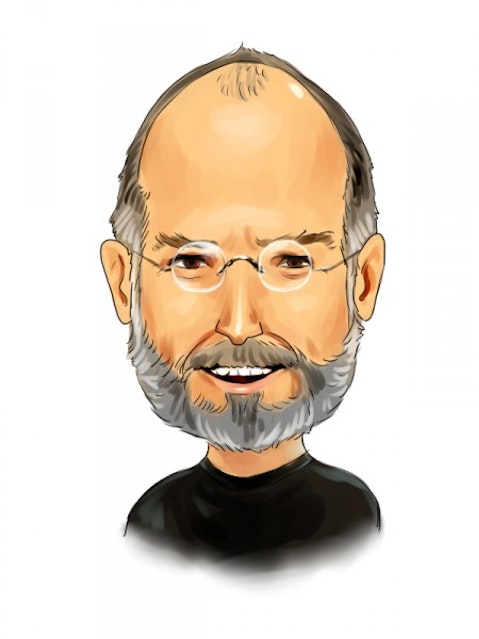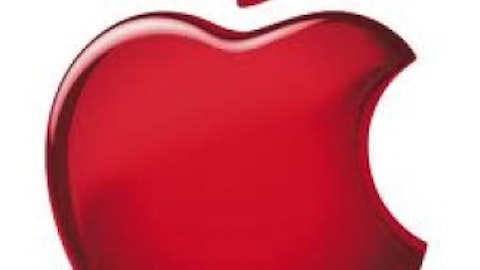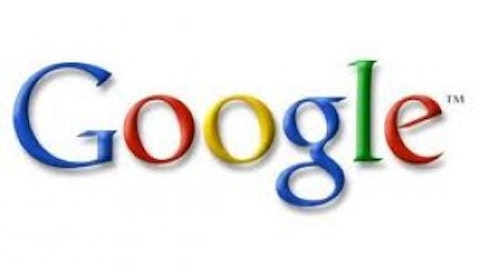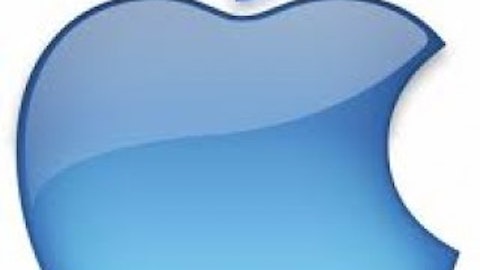Apple Inc. (NASDAQ:AAPL) is one of the most popular stocks among Wall Street analysts. According to Thomson/First Call 48 of the 58 analysts covering the stock have a buy or strong buy rating on the stock. Apple’s one year median price target of $750 is also 47% higher than its current price. Analysts also expect that Apple Inc. (NASDAQ:AAPL) will make $49 in its current fiscal year ending September 2013 and $57 in FY2014. Even the most bearish analyst thinks AAPL will earn $41.75 in FY2013. So, according to Wall Street Apple’s forward price-earnings ratio is at most 12.
Apple also currently has $128 per share in cash and investments on its balance sheet. After backing this out, Apple trades at a forward PE ratio of 9.5 according to the most bearish analyst. Apple’s forward PE ratio (excluding cash) falls to 8 if we use analysts’ consensus estimate. That’s a really cheap valuation for a stock that is expected to grow its earnings by 21% over the next 5 years. That’s not a typo. Wall Street analysts expect Apple Inc. (NASDAQ:AAPL) to grow its earnings per share to $125 in 5 years. That’s an estimated annual growth rate of 20.7% for a $500 billion company.
Don’t be fooled by these wild estimates. Just three months ago the same analysts expected earnings of $53.30 per share for FY2013, almost 10% higher than their current estimates. Their EPS estimate for FY2014 was also $61 just three months ago. Analysts’ current year estimates are starting to get more realistic but their really haven’t updated their 5-year estimates. Let’s take a closer look.
Apple Inc. (NASDAQ:AAPL) earned $44.15 in its 2012 fiscal year. So, analysts expect a 10.5% increase in earnings in 2013. Three months ago their 2013 growth estimate was 20.7%, same as their 5-year growth estimate. I am extremely skeptical about all of these estimates. Here is why:
1. None of these analysts take into account a major change in consumer’s preferences towards Apple products. Thirty years ago Sony was the Apple of the day. Ten years ago Nokia was introducing the coolest phones. It is inevitable that consumers will notice that Apple’s products aren’t as superior as they once were and they will stop paying the huge premiums Apple is charging right now.
2. Apple Inc. (NASDAQ:AAPL)’s gross profit margin will probably shrink this quarter. That’s what the company said in October. Introduction of a high cost iPhone and lower margin iPad mini is the reason behind this. Apple needs to keep doing this to increase its sales. It hopes that the increase in sales will make up for the decline in margins.
3. Apple Inc. (NASDAQ:AAPL) used to be once step ahead of its competitors. Not anymore. iPhone 5 isn’t the clear choice over Samsung Galaxy S III and iPad has several credible alternatives. Steve Jobs’ tenacious pursuit of perfection was the key ingredient of Apple’s success. We will probably find out in a year or two that Apple won’t be able to come up with another game changing product such as Apple TV.
I am certain that Apple Inc. (NASDAQ:AAPL) won’t be able to grow its earnings at a 20% rate over the next 5 years. Wall Street analysts are wrong. However, I still like the stock and have a small position. Google Inc (NASDAA:GOOG), Microsoft (NASDAQ:MSFT), Kimberly-Clark Corporation (NYSE:KMB), and Altria (NYSE:MO) are the four peers I will use in my analysis. Google is a true tech growth stock that is expected to grow its earnings by 14% over the next five years and its 2013 PE ratio is 15. As you may agree this growth estimate is a bit rosy but still more realistic than Apple’s. Microsoft is a better comparable than Google. Wall Street expects the company grow its EPS by 9% annually and the stock’s 2013 PE ratio is 9. Again, this long-term growth estimate is very optimistic.
Now let’s take a look at low growth stocks because these companies are more predictable. Kimberly-Clark grew its earnings by 4.8% over the past 5 years and it will probably perform at a similar level. Yet, Wall Street analysts expect an EPS growth rate of 10% for the next 5 years and the stock’s 2013 PE ratio is 15. Altria is expected to grow its EPS by 7.6% over the next 5 years and its 2013 PE ratio is 13.
It is clear that the market values at stable/low-growth stocks at 13-15 times earnings. Apple Inc. (NASDAQ:AAPL)’s current market valuation implies that Apple will earn $30 per share annually. The markets also tell us that Microsoft and Apple are very similar in terms of expected growth rates, i.e. both stocks will experience significant declines in their earnings. I don’t think this is very likely given the strong growth in smart phone and tablet markets. I am very certain that Apple won’t grow its earnings by 20% annually but I don’t think the company’s earnings will shrink by 30% either. I like the 2% dividend yield, share buybacks, and large cash hoard. I am willing to wait until the market acknowledges this.
Read these Apple articles too:
Is Apple Inc. (AAPL) Really Facing a ‘Radical Global Slowdown’?
One Simple Fact That Many Apple Inc. (AAPL) Investors Are Forgetting
Is Apple Inc. (AAPL) Still a Buy?





